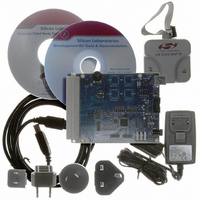C8051F700DK Silicon Laboratories Inc, C8051F700DK Datasheet - Page 11

C8051F700DK
Manufacturer Part Number
C8051F700DK
Description
DEV KIT FOR C8051F700
Manufacturer
Silicon Laboratories Inc
Type
MCUr
Datasheets
1.C8051F700-TB.pdf
(1 pages)
2.C8051F700-TB.pdf
(306 pages)
3.C8051F700-TB.pdf
(18 pages)
Specifications of C8051F700DK
Contents
Board, Cables, CD, Debugger, Power Supply
Processor To Be Evaluated
C8051F7x
Processor Series
C8051F7xx
Interface Type
USB
Operating Supply Voltage
3.3 V
Lead Free Status / RoHS Status
Lead free / RoHS Compliant
For Use With/related Products
C8051F7xx
Lead Free Status / Rohs Status
Lead free / RoHS Compliant
Other names
336-1635
6.3. System Clock Sources
6.3.1. Internal Oscillator
The C8051F700 devices feature a calibrated internal oscillator which is enabled as the system clock source on
reset. After reset, the internal oscillator operates at a frequency of 24.5 MHz (±2%) by default, but may be
configured by software to operate at other frequencies. Therefore, in many applications an external oscillator is not
required. However, if you wish to operate the C8051F700 device at a frequency not available with the internal
oscillator, an external oscillator source may be used. Refer to the C8051F70x datasheet for more information on
configuring the system clock source.
6.3.2. External Oscillator Options
The main board is designed to facilitate the use of external clock sources. To use an external CMOS clock source,
the clock can simply be applied to P0.3. For RC and C modes, place a shorting block on header J10. To implement
the RC mode option, placeholders for an 0805-packaged capacitor (C17) and resistor (R14) are supplied on the
board. The C (capacitor) clock option can be implemented by using only the capacitor placeholder (C17). To
reduce the amount of stray capacitance on the pin, which could affect the frequency in either RC or C mode,
resistor R13 can also be removed from the board when using C or RC mode. To implement external crystal mode,
place shorting blocks at headers J9 and J10 and install the crystal at the pads marked Y1. Install a 10 M resistor
at R13 and install capacitors at C17 and C18 using values appropriate for the crystal you select. Refer to the
C8051F700 datasheet for more information on the use of external oscillators.
6.4. Switches and LEDs
Two push-button switches are provided on the main board. Switch RESET is connected to the RESET pin of the
C8051F700. Pressing RESET puts the device into its hardware-reset state. Switch SW1 P1.1 can be connected to
the C8051F700’s general purpose I/O (GPIO) pin P1.0 through header J8. Pressing Switch SW1 P1.1 generates a
logic low signal on the port pin. Remove the shorting block from the J8 header to disconnect Switch SW1 P1.1 from
the port pin.
Four capacitive sense switches are provided on the target board. The operation of these switches require
appropriate firmware running on the C8051F700 MCU that can sense the state of the switch. See Section "5.3.
Capacitive Sense Switch Example" on page 6 for details about example source code.
Three LEDs are also provided on the target board. The red LED labeled USB PWR (DS1) is used to indicate a USB
connection to P4. The red LED labeled DS2 indicates when power is being applied to the board through J15.
Finally, the green LED labeled P1.0 (DS2) can be connected to the C8051F700’s GPIO pin P1.0 through header
J8. Remove the shorting block from the header to disconnect the LED from the port pin.
See Table 1 for the port pins and headers corresponding to the switches and LEDs.
Capacitive Sense Switch
Capacitive Sense Switch
Capacitive Sense Switch
Capacitive Sense Switch
Push-button Switch
Push-button Switch
Description
Green LED
Red LED
Red LED
Table 1. Target Board I/O Descriptions
Label
SW1
SW2
DS3
DS2
DS1
C1
C2
C3
C4
Rev. 0.2
5V_VBUS
RESET
VDD
P1.1
P2.0
P2.1
P2.2
P2.3
P1.0
I/O
C8051F700-DK
Header
none
none
none
none
none
none
none
J8
J8
11








